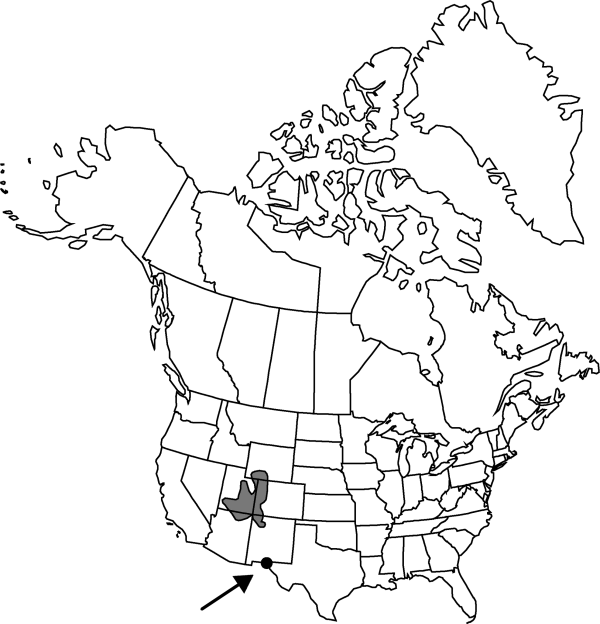Difference between revisions of "Atriplex saccaria var. asterocarpa"
Rhodora 102: 420. 2001.
FNA>Volume Importer |
FNA>Volume Importer |
||
| Line 8: | Line 8: | ||
}} | }} | ||
|common_names=Starbract orach | |common_names=Starbract orach | ||
| − | |basionyms={{Treatment/ID/ | + | |basionyms={{Treatment/ID/Basionym |
|name=Atriplex asterocarpa | |name=Atriplex asterocarpa | ||
|authority=Stutz | |authority=Stutz | ||
| + | |publication_title=G. L. Chu & S. C. Sanderson, Madroño | ||
| + | |publication_place=41: 199, fi gs. 1, 2. 1994 | ||
}} | }} | ||
|synonyms= | |synonyms= | ||
| Line 27: | Line 29: | ||
|elevation=1100-1400 m | |elevation=1100-1400 m | ||
|distribution=Ariz.;Utah. | |distribution=Ariz.;Utah. | ||
| − | |discussion=<p>This taxon is allied to both <i>Atriplex saccaria</i> and A. cornuta but distinguished mainly by the fruiting bracteoles profusely covered with hard, thickened processes. Evidently absent in specimens of <i></i>var.<i> asterocarpa</i> are the small, cuneate, truncate, smooth bracteoles typical of <i>A. saccaria</i>, but in some specimens the juvenile fruiting bracteoles suggest such a condition, which is noted both in <i></i>var.<i> saccaria</i> proper and in <i></i>var.<i> cornuta</i>. The overall aspect of <i></i>var.<i> asterocarpa</i> is, despite lacking this one feature, that of <i>A. saccaria</i>. This is apparently the basis of my earlier interpretation of A. caput-medusae within <i>A. saccaria</i>.</p> | + | |discussion=<p>This taxon is allied to both <i>Atriplex saccaria</i> and A. cornuta but distinguished mainly by the fruiting bracteoles profusely covered with hard, thickened processes. Evidently absent in specimens of <i></i></i>var.<i><i> asterocarpa</i> are the small, cuneate, truncate, smooth bracteoles typical of <i>A. saccaria</i>, but in some specimens the juvenile fruiting bracteoles suggest such a condition, which is noted both in <i></i></i>var.<i><i> saccaria</i> proper and in <i></i></i>var.<i><i> cornuta</i>. The overall aspect of <i></i></i>var.<i><i> asterocarpa</i> is, despite lacking this one feature, that of <i>A. saccaria</i>. This is apparently the basis of my earlier interpretation of A. caput-medusae within <i>A. saccaria</i>.</p> |
|tables= | |tables= | ||
|references= | |references= | ||
| Line 51: | Line 53: | ||
|publication year=2001 | |publication year=2001 | ||
|special status= | |special status= | ||
| − | |source xml=https://jpend@bitbucket.org/aafc-mbb/fna-data-curation.git/src/ | + | |source xml=https://jpend@bitbucket.org/aafc-mbb/fna-data-curation.git/src/f6b125a955440c0872999024f038d74684f65921/coarse_grained_fna_xml/V4/V4_669.xml |
|genus=Atriplex | |genus=Atriplex | ||
|subgenus=Atriplex subg. Obione | |subgenus=Atriplex subg. Obione | ||
Revision as of 20:02, 24 September 2019
Herbs, annual, 1.5–3 dm. Stems erect, branching from base to top, terete, scurfy above. Leaves: petiole 2–10 mm; blade oval to narrowly so, 6–15(–25) × 5–10(–15) mm, base truncate to rounded or rather abruptly cuneate, margin entire, apex acute to rounded. Staminate flowers in glomerules arranged in spikes 1–3 cm at branch apices. Fruiting bracteoles always (?) monomorphic, usually on stipes 2–6 mm, body 5–6 mm thick, globose, with thickened, hard, hornlike appendages.
Phenology: Flowering Apr–Sep.
Habitat: Fine-textured, saline (frequently semibarren) substrates of the Chinle and Entrada formations, with Atriplex confertifolia, Phacelia crenulata, and Eriogonum inflatum
Elevation: 1100-1400 m
Discussion
This taxon is allied to both Atriplex saccaria and A. cornuta but distinguished mainly by the fruiting bracteoles profusely covered with hard, thickened processes. Evidently absent in specimens of var. asterocarpa are the small, cuneate, truncate, smooth bracteoles typical of A. saccaria, but in some specimens the juvenile fruiting bracteoles suggest such a condition, which is noted both in var. saccaria proper and in var. cornuta. The overall aspect of var. asterocarpa is, despite lacking this one feature, that of A. saccaria. This is apparently the basis of my earlier interpretation of A. caput-medusae within A. saccaria.
Selected References
None.
